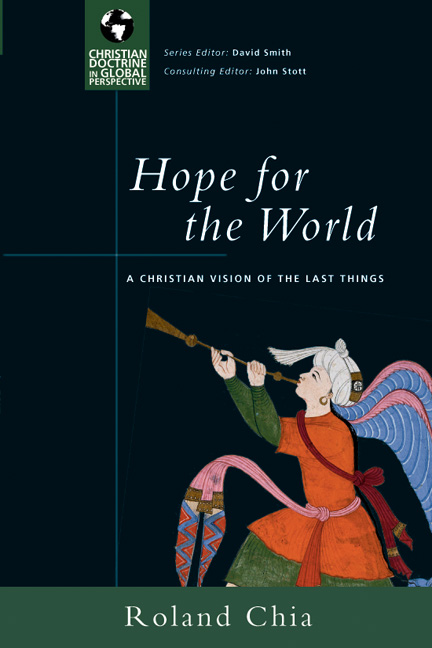Roland Chia: Hope for the World
 Roland Chia, Hope for the World: A Christian Vision of the Last Things,Christian Doctrine in Global Perspective Series; series editor David Smith, consulting editor John Stott (Downer’s Grove: IVP Academic, 2005), 164 pages.
Roland Chia, Hope for the World: A Christian Vision of the Last Things,Christian Doctrine in Global Perspective Series; series editor David Smith, consulting editor John Stott (Downer’s Grove: IVP Academic, 2005), 164 pages.
Roland Chia has written a clear and concise alternative to an all-too-common array of eschatological texts ranging from watered down and weightless to way out and weird. His is neither. The contribution of Chia (Trinity Theological College, Singapore) to the Christian Doctrine in Global Perspective series, edited by acknowledged Evangelical heavies David Smith and John Stott, is stimulating and substantive. Here the series admirably achieves its twin goals of providing texts informed by non-Western Christianity but still applicable for Western Christians. This positive combination is significantly assisted by Chia’s obvious familiarity and intimacy with the Southeast Asian religious context and that of the West as well. The result is exceptional eschatological analysis.
Chia begins by underlining the nature and need of hope in the Asian context. He does not shy away from speaking to issues of terrorism and peace, wealth and poverty, or world religions and worldly ideologies, but sounds a hopeful note bravely based on Christian belief. In fact, he sharply distinguishes secular optimism in cultural or technological progress from Christian hope in Christ. Chia briefly surveys the hope of Israel, accenting the Kingdom of God, the Messiah, and the day of the Lord, but addressing the afterlife too, and of the Church, here accenting Jesus’ teaching on the Kingdom and its timing along with Paul’s vision of the future as “already-not yet” (a partially and provisionally realized eschatology). Then Chia starts tackling specific topics. In successive sections alternating between individual and cosmic eschatology, he discusses death, the intermediate state, and the resurrection, and then the coming of the Lord and the last judgment before exploring the respective fates of the righteous and wicked and the eternal order of the coming new world. The final chapter brings us back to the present, persuasively exhorting us to an eschatological lifestyle characterized as “living in hope”. For Chia the Church is a worshiping community graced by “eschatological moments” ever energizing its hope; faces the fact of evil and suffering in this present age with an inspiring hope; and, expressing hope in Christ openly and personally through commitment to the discipline of discipleship as an identification with and participation in the cross and resurrection of Christ. Chia effectively integrates dimensions of hope often assumed disparate into a present and future dynamic with transforming power for life here and now as well as forever and always. The book concludes with careful endnotes and a Scripture index, but has no person or subject indexes.


